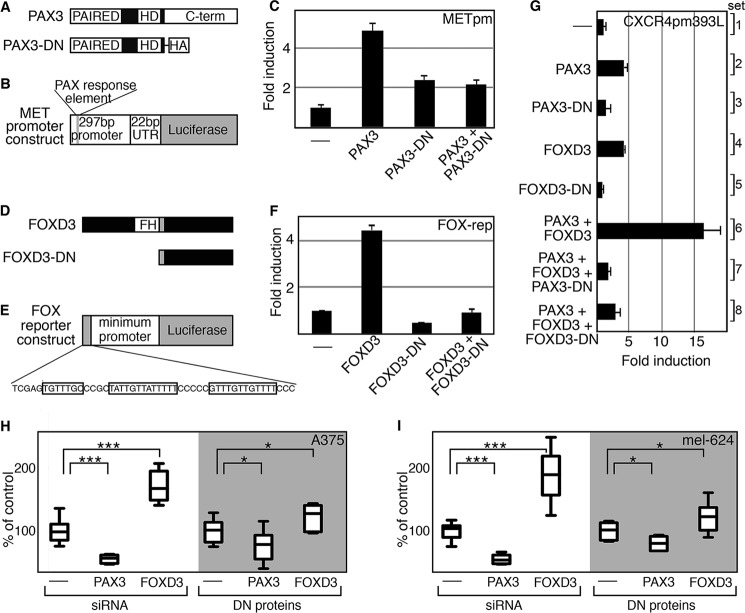FIGURE 6.
Dominant-negative PAX3 and FOXD3 proteins inhibit wild-type protein transcriptional function and melanoma cell growth. A, a schematic comparison of PAX3 wild-type and dominant-negative (PAX3-DN) proteins. B, schematic diagram of a PAX3-responsive reporter construct, containing sequence comprised of the UTR and 5′ proximal promoter segments of the MET gene. This reporter is PAX3 responsive, as previously reported (15). C, PAX3-DN protein inhibits the ability of wild-type PAX3 to activate a reporter construct containing the MET promoter. PAX3 promoted luciferase activity 4.47 ± 0.43-fold over reporter levels alone, whereas the addition of PAX3-DN reduced these levels (all p < 0.0005). D, schematic comparison of FOXD3 wild-type and dominant-negative (FOXD3-DN) proteins. E, schematic of a synthetic FOX reporter construct. The gene cassette contains three FOX binding motifs (as shown, boxed) cloned 5′ to a minimum promoter element that is upstream of a luciferase open reading frame. F, FOXD3-DN blocks the ability of FOXD3 to drive luciferase expression. FOXD3 drove luciferase activity 4.48 ± 0.18-fold over reporter levels alone, whereas the addition of FOXD3-DN inhibited this activation (all p < 0.0005). G, dominant-negative PAX3 and FOXD3 block the ability of the wild-type proteins to activate expression through the CXCR4 intronic enhancer. PAX3-DN and FOXD3-DN alone did not drive luciferase activity from the CXCR4 reporter vector (sets 3 and 5, respectively, p > 0.2). The dominant-negative proteins significantly inhibited the synergistic activation of the CXCR4 reporter by PAX3 and FOXD3 (PAX3-DN, set 7; FOXD3-DN, set 8; p < 0.0005 compared with set 6). H and I, dominant-negative protein expression or siRNA targeting of PAX3 or FOXD3 results in similar consequences in melanoma cell growth. A375 (H) and mel-624 (I) cells were transfected with Scramble siRNA (control, first lanes), or siRNA targeted against PAX3 or FOXD3 (second and third lanes). Cells were also transfected with empty vector (fourth lanes) or with PAX3-DN or FOXD3-DN expression constructs (fifth and sixth lanes). Growth changes seen for PAX3 or FOXD3 inhibition are significant when compared with controls (*, p < 0.05; ***, p < 0.0005).

